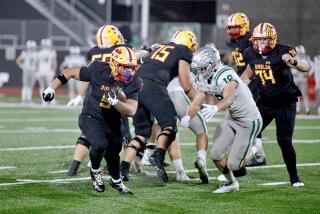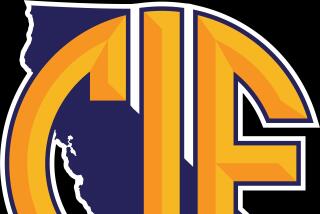Open Enrollment, Close Doors? : Legislation: New law could create district super teams, denying some students a chance to play.
- Share via
Open enrollment might forever alter the face of high school athletics, leading to the formation of high-powered “district teams” that compete in super leagues based on district enrollment.
Far-fetched?
Not to Bob Cooper, the Hoover High baseball coach of 20 years. After examining new legislation that permits students to attend any school within a district, he offers a hypothetical example in the Glendale Unified School District.
Glendale High, with its first-rate stadium, would field the district football team. Crescenta Valley would field the basketball team and Hoover the baseball team. Players wishing to participate at the highly competitive district level would attend the school fielding the particular team.
Schools also would field less competitive “club teams,” creating a two-tiered system of high school athletics.
“My feeling is that (open enrollment) is going to put some schools out of certain sports,” Cooper said. “It might start with small sports. If you want to play, you go to this school.
“I think it’s sad, because a tremendous number of kids will not be able to participate.”
The idea of district teams, startling at first, has some appealing aspects. Undue influence and transfer rules become immaterial. Money is saved. A superb level of competition is born.
It might start this way: A district decides that any student wanting to swim or play water polo attend the only district school with a pool. A district golf team is next. Then a wrestling team.
In major sports, the trend would begin with the best players gravitating to a particular school because of its superior program. Soon, a district team would be in place, like it or not.
Colorado has had open enrollment for two years. Already, there is a move toward district teams.
“We call them athletic magnet schools, and that may very well be the direction high school activities are going,” said Bert Borgmann, assistant commissioner of athletics in Colorado.
Colorado took the first step this year by implementing a rule that allows schools to combine teams with neighboring schools if those schools are unable to field a team. Gymnastics and other minor sports already have fielded what Borgmann terms “cooperative teams.”
Closer to home, check out the Crenshaw boys’ basketball team. Nine transfer students have made the Cougars one of the best teams in the nation. Their games are more of a con than a contest.
“Once you become a dynasty, other schools get discouraged,” said Francis Nakano, an assistant superintendent in the L.A. Unified School District. “People tend to hate you when you win all the time.”
Under a district team plan, Crenshaw might get some competition instead of the steady barrage of scorn it receives now. The City Section, with 49 high schools, could be broken into perhaps 10 sub-districts for the purposes of forming district teams.
“Crenshaw is the standard, the granddaddy of all recruiters, the team all recruiters strive to equal,” Taft basketball Coach Jim Woodard said with more than a trace of sarcasm.
District teams would eliminate the need to recruit. Any player who wants to play with the best simply tries out.
The most heated competition might be among coaches: Who gets the district team?
More to Read
Get our high school sports newsletter
Prep Rally is devoted to the SoCal high school sports experience, bringing you scores, stories and a behind-the-scenes look at what makes prep sports so popular.
You may occasionally receive promotional content from the Los Angeles Times.







